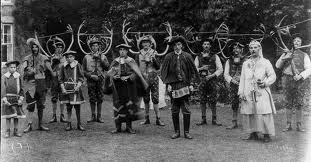The tune was sent to British folksong collector Cecil Sharp in 1910 by a Mr. Buckley, an Abbots Bromley resident who noted the tune in 1857 or 1858. He learned it from William (or Henry) Robinson, the town's wheelwright and a very good fiddle player.
There are 12 dancers. Six carry the horns and they are accompanied by a musician playing an accordion (a violin in former times), Maid Marian (a man in a dress), the Hobby-horse, the Fool (or Jester), a youngster with a bow and arrow, and another youngster with a triangle. Traditionally, the dancers are all male, although in recent years girls have been seen carrying the triangle and bow and arrow.
As described by Cecil Sharp, there are six figures in the dance. He describes the dance as being done with the participants in a single line; however, it is currently performed with the dancers in a double column.

It was printed in Sharp's Sword Dances of Northern England, Book II (1912).
It was recorded by The Telemann Society.